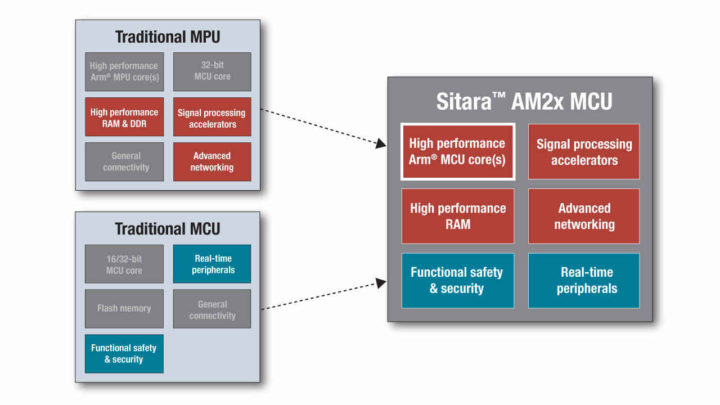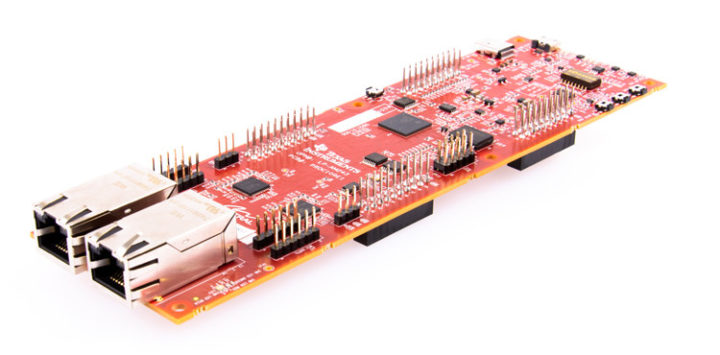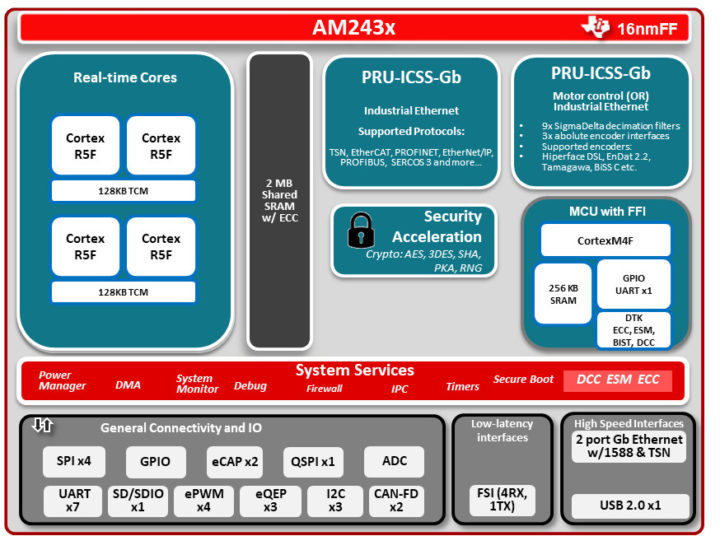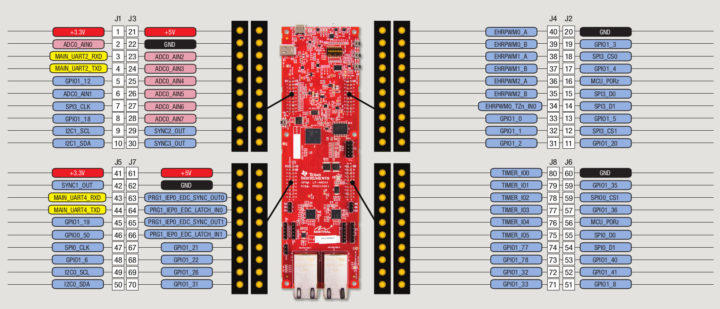The few microcontroller boards that get Ethernet, are often limited to 10 Mbps or 100 Mbps, but the LP-AM243 LaunchPad development kit comes with two Gigabit Ethernet ports controlled by the newly announced 800 MHz Texas Instruments Sitara AM243x Cortex-R5F microcontroller with industrial communication and security features.
TI Sitara AM243x Cortex-R5F microcontroller

The Sitara AM243x family is comprised of three processors with one, two, or four cores with the following key features and specifications:
- CPU
- AM2431 – Single-core Cortex-R5F real-time core @ 800 MHz with 128KB
TCM - AM2432 – Dual-core Cortex-R5F real-time core @ 800 MHz with 64KB TCM per core
- AM2434 – Quad-core Cortex-R5F real-time core @ 800 MHz 64KB TCM per core
- Cache – 32KB ICache and 32KB DCache per R5F core with SECDED ECC on all memories
- Single-core isolated Arm Cortex -M4F MCU @ 400 MHz with 256KB SRAM with SECDED ECC
- AM2431 – Single-core Cortex-R5F real-time core @ 800 MHz with 128KB
- System Memory
- 2MB shared SRAM with ECC
- External LPDDR4, DDR4 memory types supported
- Storage I/F
- 2x MultiMedia Card/Secure Digital (MMC/SD), one 4-bit for SD/SDIO, one 8-bit for eMMC
- 1x General-Purpose Memory Controller (GPMC) – 16-bit with 133 MHz clock or 32-bit with 100 MHz clock
- 1x Flash Subsystem (FSS) that can be configured as Octal SPI (OSPI) flash interfaces or one Quad SPI (QSPI)
- Networking/Communication interfaces – 2x Gigabit Industrial Communication Subsystems (PRU_ICSSG) with optional support for Profinet IRT, Profinet
RT, EtherNet/IP, EtherCAT, Time-Sensitive Networking (TSN), and other Networking Protocols - High-speed serial interfaces
- Integrated Ethernet switch supporting up to 2 RGMII (10/100/1000) (Gigabit Ethernet) interfaces compliant with IEEE 1588, Energy-efficient Ethernet (802.3az)
- Single-lane PCI-Express Gen2 controller (PCIe)
- 1x USB 3.1-Gen1 Dual-role Device (DRD)
- 1x Serializer/Deserializer (SERDES) to support PCI-Express Gen2 and USB SuperSpeed Gen1
- General peripherals
- 6x I2C, 9x UART
- 12-bit Analog-to-Digital Converters (ADC) up to 4 MSPS
- 8x multiplexed analog inputs
- 7x Multichannel Serial Peripheral Interfaces (MCSPI) controllers
- 3x General-Purpose I/O (GPIO) modules for up to 198 GPIOs
- Industrial peripherals
- 9x Enhanced Pulse-Width Modulator (EPWM) modules
- 3x Enhanced Capture (ECAP) modules
- 3x Enhanced Quadrature Encoder Pulse (EQEP) modules
- 2x Modular Controller Area Network (MCAN) modules with full CAN-FD support
- 2x Fast Serial Interface Transmitter (FSI_TX) cores
- 6x Fast Serial Interface Receiver (FSI_RX) cores
- Security
- Secure Boot, secure storage
- Cryptographic acceleration – AES up to 256-bit, 3DES up to 168-bit, MD5, SHA1, up to 512-bit SHA2, DRBG with true random number generator, PKA (Public Key Accelerator) to Assist in RSA/ECC processing
- Trusted Execution Environment via Arm Trustzone
- Functional safety support
- Package
- 441-pin FCBGA 17.2 x 17.2 mm package, 0.8-mm pitch
- 293-pin FC/CSP (Flip-Chip Chip Scale Package) 11 x 11 mm package, 0.5-mm pitch
Texas Instruments claims 10 times the processing performance of other solutions, considering support for Gigabit Ethernet, instead of just 100 Mbps in other solutions, albeit the high-end 1GHz NXP i.MX RT1170 crossover Cortex-M7/M4 “processor” also supports two Gigabit Ethernet interfaces with AVB and TSN support.
Gigabit Ethernet and other features make the AM243x microcontrollers suitable for high-end applications such as factory automation, robotics, automotive systems, and sustainable energy management. One specific use case would be predictive maintenance to reduce downtime on factory floors, and since power consumption is under 1W while active, existing power resources can be extended to lowering both the operating costs and energy footprint.
LP-AM243 Launchpad development kit

- SoC -TI Sitara AM2434 quad-core Cortex-R5F @ 800 MHz + 1x Cortex-M4F @ 400 MHz microcontroller
- Storage – 512Mbit QSPI flash
- Networking – 2x Gigabit Ethernet RJ45 ports capable of 1Gb or 100Mb speeds
- Expansion
- Dual 40 pin BoosterPack plugin module interface
- CAN transceiver
- Debugging – On-board XDS110 debug probe emulator
Texas Instruments provides an out-of-the box experience page with a getting started guide, a benchmark demo, access to the MCU SDK for Windows and Ubuntu with examples, and more resources. You can also find the datasheet and a 7410 pages long technical reference manual for the processor itself on TI developer website.
Availability and Pricing
Texas Instruments says preproduction versions of the AM2431, AM2432 and AM2434 microcontrollers are now available with pricing starting at US$6.05 for 1,000-unit quantities, but when I go to the AM2431’s product page I can only find it for $12.97 for 1k orders. The AM243x LaunchPad development kit can be purchased for US$89 directly on TI website.

Jean-Luc started CNX Software in 2010 as a part-time endeavor, before quitting his job as a software engineering manager, and starting to write daily news, and reviews full time later in 2011.
Support CNX Software! Donate via cryptocurrencies, become a Patron on Patreon, or purchase goods on Amazon or Aliexpress






